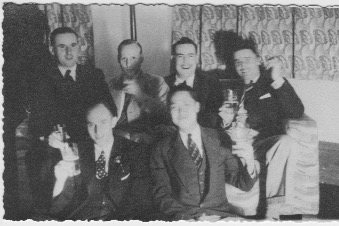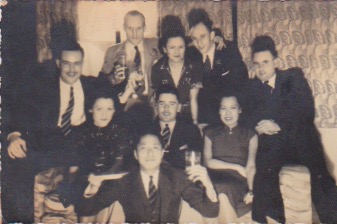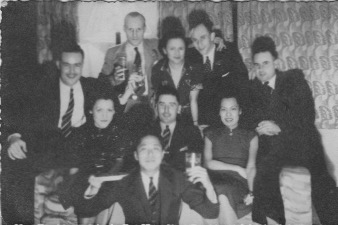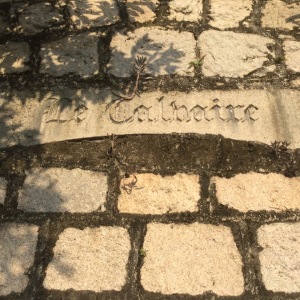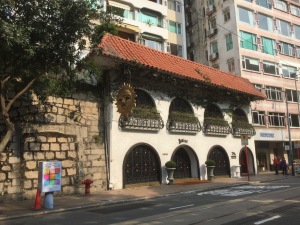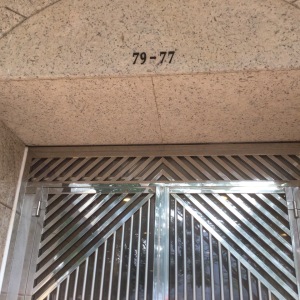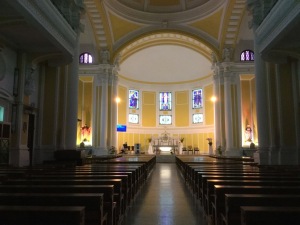For me, and I’m sure many others, the most resonant area in what was once Stanley Civilian Internment Camp is the small cemetery where the internees buried their dead and marked their graves with stones hewn and inscribed by a Russian police officer.
The cemetery was used in the early years of the Colony to bury British military personnel and their families, most of whom had succumbed to Hong Kong’s harsh (for Europeans) climate and the diseases it brought. It had been closed for a long time by 1941, but was re-opened to house those who died in Stanley. In this post I want to try to reconstruct the way in which the internees used the space available for burials. It is important to remember that the current cemetery is enlarged, added to and modified in various ways. And what are now CWGC stone memorials were wooden crosses as late as 1953. In the immediate post-war years the small cemetery must have made an even more powerful impact on visitors.
Let’s start by orientating ourself. This is the path that leads from St Stephen’s College down into the graveyard:

Bungalow C (more of which later) is just the other side of this path. All future directions as to left/right are from the perspective of someone walking down this path from the school. That means the sea is on your right; and here’s the view back up the path from a little way down: the curved graves are Victorian, the tall stones post-war:
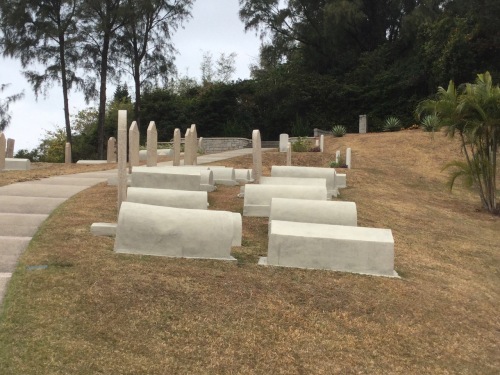
A little further down we see two areas containing graves of children who died in Stanley Camp:
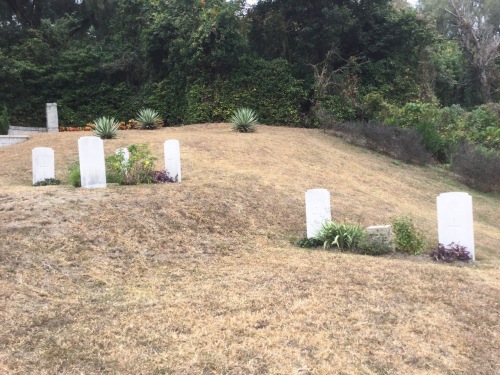
All of the memorials are post-war, expect for the one marking the grave of Brian Gill, which is the first of the 1942-1945 stones we’ve encountered:
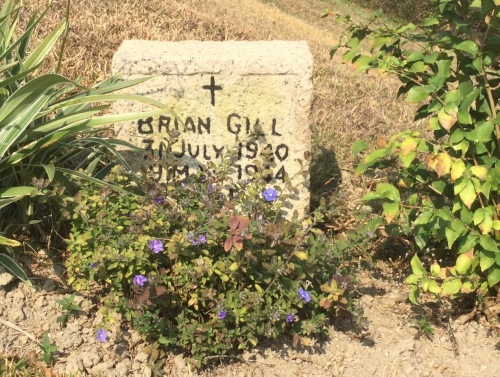
Brian died tragically in a drowning accident in May 1944, which, as we shall see, means his grave is not where we would expect it. My theory is this: children who died had their graves marked with a cross not a stone, and were all buried in this area – Brian Willey, who is commemorated on the stone to the (viewer’s) left of Brian Gill died on January 24, 1942, so was probably the first internee of any age to pass – his burial at this point might have established the area as one for the internment of children. After the war, the crosses were replaced with stones, which is why Brian Gill’s is the only original marker.
These two photos of one of the children’s areas in 1945 (courtesy of the Imperial War Museum’s non- commercial licence and kindly drawn to my attention by Sandy Wynd) support this theory (and show how different the cemetery was at that time):
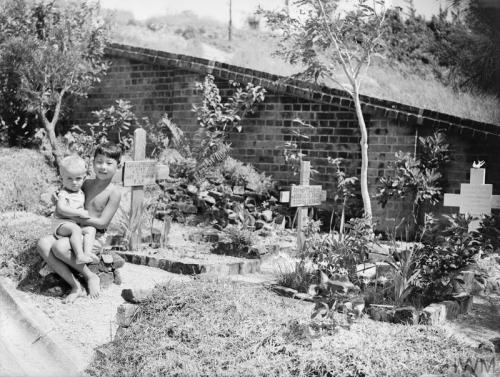
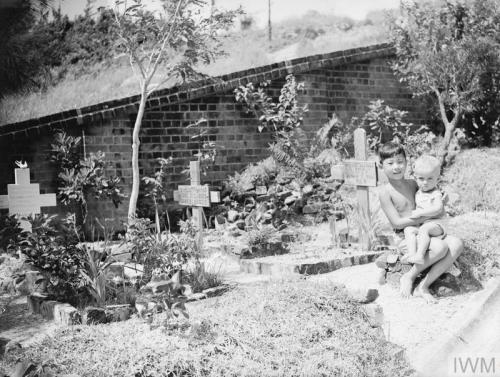
The photos show Juan (or possibly Duane) and Dennis Clarke, who were interned with their parents, at the grave of their brother Anthony, who died on December 14, 1942 at the age of 12 days. If the IWM account is correct, this was one of the most poignant deaths from malnutrition in the camp.
My guess is that the original plan was to bury everyone starting from Brian Willey’s grave and moving downhill, but for some reason it was decided to continue a little bit further down. This is the view from the children’s graves to what was to become the main part of the cemetery:
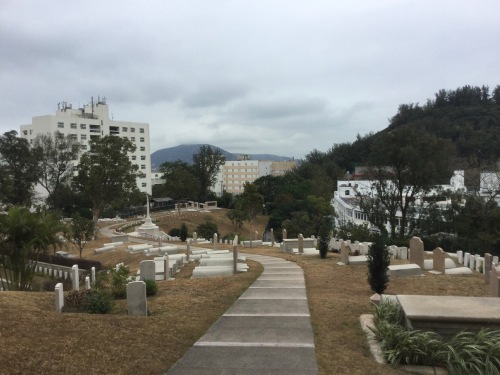
The memorial (the large cross on a rounded plinth) is post-war, as is the white building on the left.
These are the first adult graves (you can see the white building again):

We are now going to see graves moving generally speaking down the hill (and keeping to the left side of the path), but Charles Bond died before John Shephard, and there was never an attempt to bury people in geometrical progression. There was plenty of space (the death rate in Stanley was remarkably low), so later graves could be dug in front of earlier ones:
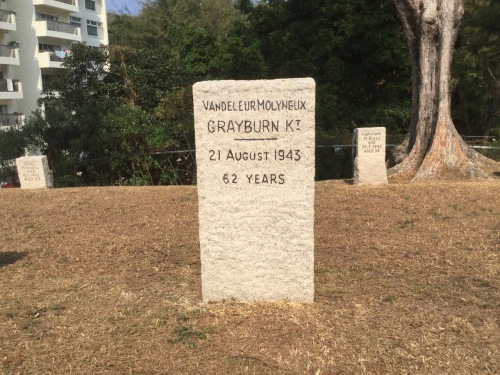
Grayburn was never in Stanley. He died of malnutrition in the prison next to the camp, and because his wife was an internee (sharing Bungalow D with my parents and about 20 others) he was brought to the cemetery for burial. He was head of the HSBC and well-known throughout East Asia. He had been sent to prison for trying to smuggle money into camp – he and his fellow bankers had raised millions of pounds in today’s terms for relief work all over Hong Kong. His funeral probably saw the largest ever gathering in this cemetery.
In 1944 the ‘layering’ of graves on the left side of the path continued. This one had not only a short quotation, but an unusual visual adornment:
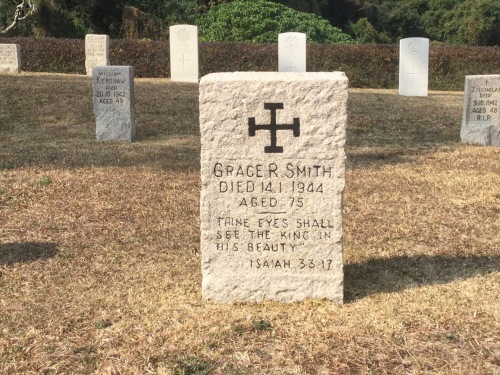
But that’s not the only reason for examining this photo. If you look to your left and go behind the grave of William Kershaw you will see two wartime stones, one marking the grave of Sgt. White of the Volunteers, and the other that of Abdul Haq, a gunner in the Hong Kong and Singapore Royal Artillery who was killed on December 25, 1941. I think that Sergeant White was Norbert Leyburn White, who died on December 22nd.
The site of Stanley Camp had seen some of the bitterest fighting of the war. One of the things the internees had to do to make their new home livable was to find and bury the bodies that lay inside or just outside their perimeter. These are clearly the graves of two soldiers who fell in the defence of the Stanley area – the Japanese were fighting their way to Stanley Fort, where many soldiers from other units had retreated, and which would have been the centre of a ‘last stand’ if the British hadn’t surrendered. My guess is that these burials took place in late January or early February 1942 – most internees arrived on January 21. This is quite a way down the hill from the children’s graves, so it’s probable that at this early stage there was no consistent policy as to where people should be buried. I think that begins with the graves of Bond and Shephard (above).
The layering policy continued into 1945: here are two graves from that year close to one from 1944:
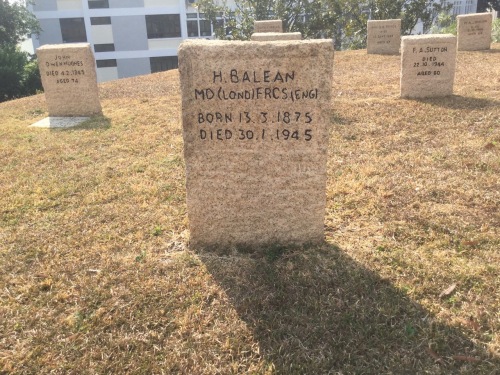
‘F. A. Sutton’ was better known as One Arm Sutton, a general in the Chinese army who died of malnutrition and some would say despair. Interestingly, only three British men ever became Chinese generals: the best known is Gordon of Khartoum (aka ‘Chinese Gordon’) and the other two were in Stanley (Morris ‘Two-Gun’ Cohen was repatriated with the Canadians in September 1943).
When Bungalow C was accidentally bombed by the Americans in January 1945 the victims were buried on this side:
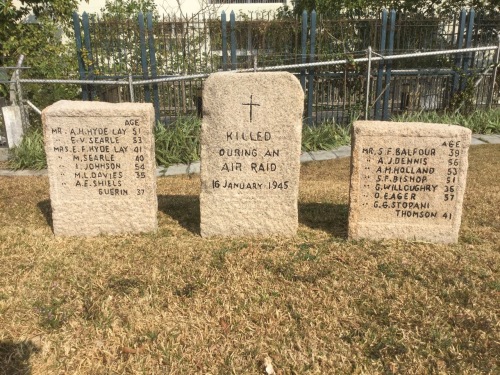
Nevertheless, at some point in 1944 burials began to take place on the right side of the path as well:
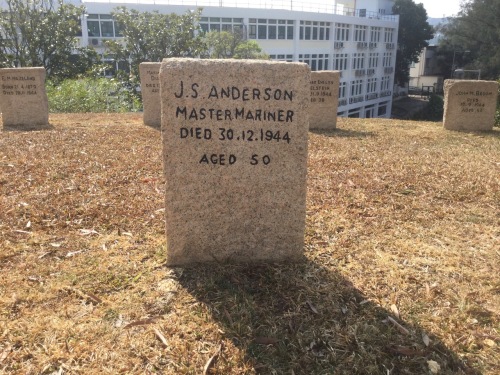
J. S. Anderson had also been in Bungalow D with my parents, but by the time he died he had moved (there was a big change around in the Bungalow in late 1944, something that made my parents’ lives a bit easier – I’ll explain why in a future post). I think the building in the background (also visible in the next photo) was the one where the American diplomats were housed before joining their co-nationals in the June 1942 repatriation.
The right side continued to be used in 1945:
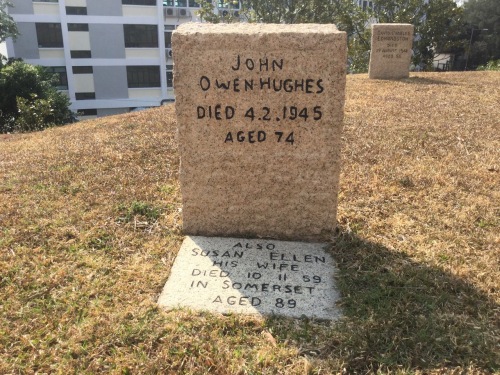
John Owen Hughes was a member of both the Legislative and Executive Councils. In the background you can see the grave of David Charles Edmondston, Grayburn’s Number 2 at the HSBC, who also died of malnutrition, about a year after his boss. Edmondston had also been part of the banker’s fund-raising effort, but in his case was imprisoned for being in contact with Consul John Reeves in Macao.
In summary, we can see that there was a general tendency to move down hill as the months went on, and to keep to the left hand side of the path. Some time in 1944 burials began on the right hand side, while continuing on the left – those on the right hand side were at roughly the same level as those on the left.
L. A. Collyer, who was in charge of Hong Kong’s mental hospital, noted in his camp diary that the graveyard was almost full by August 1945. On the face of it, there’s lots of space at different points – but I wonder if this is an illusion caused by post-war enlargements?
I’ll end with another question. This memorial to those murdered in the Christmas Day massacre at the St Stephen’s emergency hospital (which took place in another part of what was to become the camp) is to the right of the path (going downhill, as always) and close to the entrance to the College:
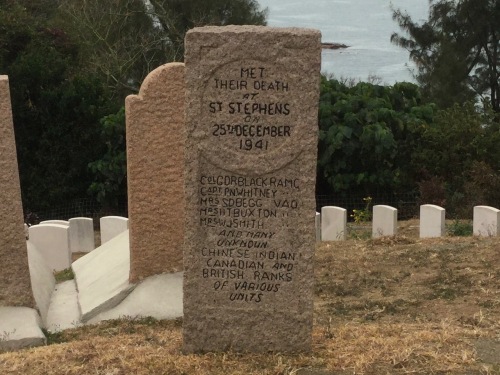
If it dates from the war, it is the largest structure to have been erected. But would the Japanese have allowed it, even with the uncontroversial wording? And the other stones are thought to have been pre-war markers – what was this larger one? Did it go up very soon after liberation?
Note: Those interested in the Cemetery might wish to consult Philip Cracknell’s carefully researched account of those who are buried here

